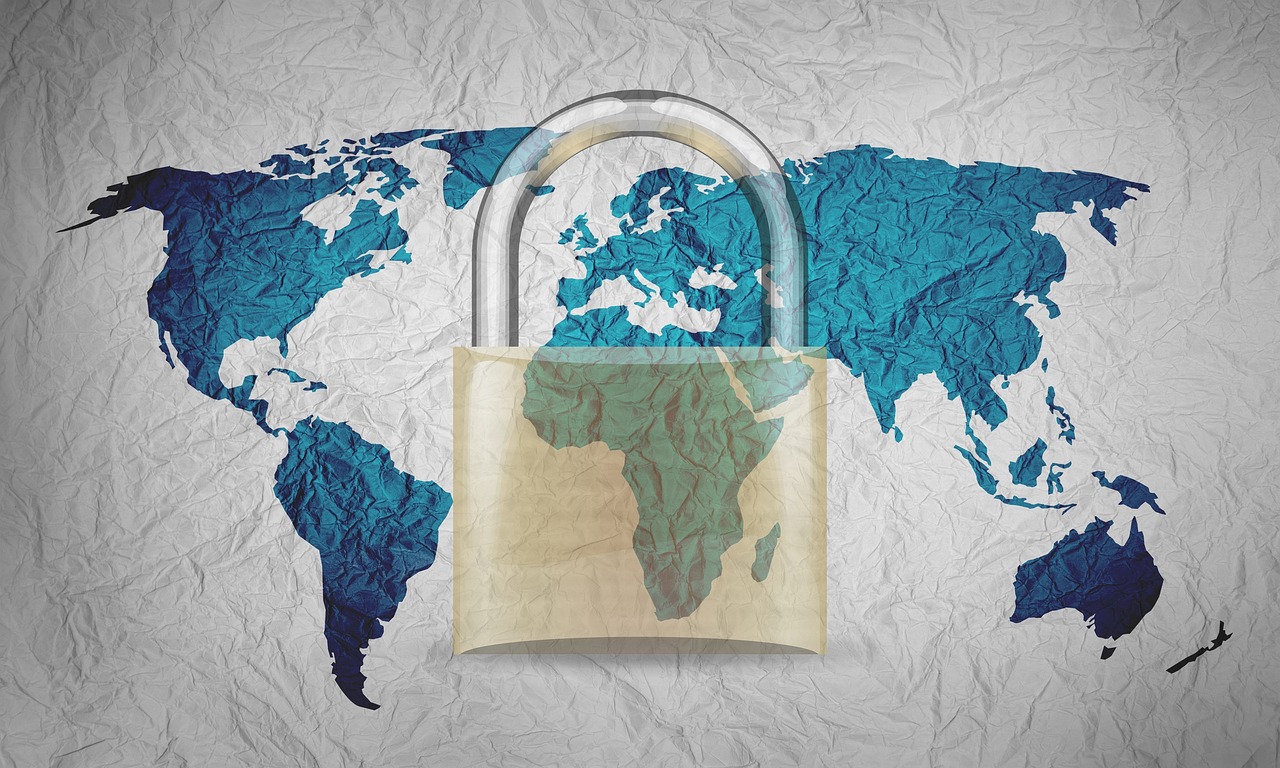How to Educate Kids About Cybersecurity
In today's digital age, where technology is as common as the air we breathe, educating kids about cybersecurity is more crucial than ever. With children spending a significant amount of time online, it's essential to equip them with the knowledge and skills they need to navigate the internet safely. But how do we approach this complex topic without overwhelming them? The key is to make learning about cybersecurity fun, engaging, and relatable. Think of it like teaching them to swim; you wouldn’t just toss them in the deep end without any guidance, right? Similarly, we need to guide our kids through the vast ocean of the internet, ensuring they know how to stay afloat and avoid potential dangers.
To kick things off, let’s dive into the basics of cybersecurity. Kids should understand concepts like personal information, passwords, and the importance of privacy. For instance, explaining that their personal data is like a treasure chest can help them grasp why they should keep it safe. You wouldn’t leave your treasure chest unlocked for anyone to rummage through, would you? By using relatable analogies, we can help them understand the significance of protecting their online identities.
As we progress, creating a safe online environment becomes paramount. This means not only talking to kids about the dangers they might encounter but also taking proactive steps to ensure their safety. Setting up parental controls is one effective strategy. Think of parental controls as a safety net, catching your child before they fall into risky situations online. But how do you choose the right software? It’s all about finding tools that are user-friendly and reliable, ensuring you can monitor their online activities without being overly intrusive.
Moreover, it’s essential to teach kids about safe online behavior. Encourage them to think critically about the content they encounter. For example, if they receive a message from someone they don’t know, they should treat it like a stranger knocking on their door—always approach with caution. This is where open communication comes into play. By fostering an environment where kids feel comfortable discussing their online experiences, we can help them navigate the digital world more confidently.
Finally, we must address the reality of online threats. From phishing scams to cyberbullying, kids need to be aware of the potential dangers lurking online. Teaching them how to identify phishing attempts can empower them to recognize suspicious emails or messages. Similarly, discussing the signs of cyberbullying is crucial. Kids should know that if they see something upsetting online, they should speak up and report it. This not only protects them but also helps create a supportive community for everyone.
In conclusion, educating kids about cybersecurity is not just a one-time conversation; it’s an ongoing dialogue that evolves as they grow and their online interactions change. By making the topic approachable and engaging, we can help them build a solid foundation for a safe digital future. Remember, the goal is to empower them to be responsible digital citizens who can explore the internet with confidence and caution.
- What age should I start teaching my child about cybersecurity?
It's best to start as early as they begin using digital devices, typically around age 5 or 6. - How can I make cybersecurity fun for my kids?
Use games, interactive activities, and relatable stories to teach them about online safety. - What are the signs that my child might be a victim of cyberbullying?
Look for changes in behavior, such as withdrawal from friends, reluctance to go online, or sudden changes in mood. - How often should I review my child’s online activity?
Regularly reviewing their online interactions, at least weekly, can help keep them safe.

Understanding Cybersecurity Basics
Teaching kids the fundamental concepts of cybersecurity is absolutely essential in today's digital age. As children increasingly engage with technology, understanding how to navigate the online world safely becomes a priority. So, what exactly is cybersecurity? At its core, cybersecurity involves protecting computers, networks, and data from unauthorized access, theft, or damage. It’s like having a digital fortress that keeps your personal information safe from intruders.
To make it easier for kids to grasp these concepts, we can break down some key terms they should know:
- Malware: This is malicious software designed to harm or exploit any programmable device. It’s like a sneaky thief trying to break into your house.
- Phishing: A technique used by cybercriminals to trick individuals into revealing personal information, often through deceptive emails or messages. Imagine someone pretending to be your friend to steal your lunch money.
- Firewall: A security system that monitors and controls incoming and outgoing network traffic based on predetermined security rules. Think of it as a security guard at the entrance of a building, checking who can come in and who can’t.
- Encryption: The process of converting information into a code to prevent unauthorized access. It’s like sending a secret message that only your best friend can read.
By familiarizing children with these terms, we can help them understand the importance of protecting their personal information in the digital world. It’s not just about avoiding dangerous websites; it’s about developing a mindset that prioritizes online safety. Encouraging kids to ask questions and explore these concepts can foster a deeper understanding of how to stay safe online.
For a more interactive approach, consider using games or apps that teach cybersecurity principles. Many educational platforms offer engaging content that makes learning about online safety fun and memorable. This hands-on experience can help solidify their understanding and make them more vigilant in their online activities.
Ultimately, instilling a sense of responsibility regarding cybersecurity in children is vital. Just as we teach them to look both ways before crossing the street, we must teach them to think critically about their online interactions. By reinforcing these basic concepts, we can empower the next generation to navigate the digital landscape safely and confidently.

Creating a Safe Online Environment
Creating a safe online environment for children is not just recommended; it's absolutely essential in today's digital age. With the vast expanse of the internet, children can easily encounter risks that may compromise their safety. As parents and guardians, it’s our responsibility to ensure that our kids can navigate the web securely. So, how do we go about this? The first step is to establish clear rules about internet usage. Just like we set boundaries in the physical world, we need to do the same in the digital realm. For instance, you might want to limit the amount of time your child spends online or specify which websites are off-limits.
Moreover, creating a safe online environment involves open discussions about what is appropriate online behavior. This means not only talking about the dangers of the internet but also discussing the importance of treating others with respect. Encourage your kids to come to you with any concerns they may have, whether it’s about something they saw online or a conversation they had with someone. This kind of open communication fosters trust and makes it easier for children to share their online experiences without fear of judgment.
Another crucial aspect is the use of technology to protect your children. Implementing parental controls can be a game-changer. These tools can help monitor your child’s online activities and limit their exposure to inappropriate content. But remember, technology alone is not enough. It should complement the education you provide about online safety. Just like teaching them to look both ways before crossing the street, we need to teach them to be cautious and aware of their digital surroundings.
When setting up parental controls, consider the following key factors:
| Factor | Description |
|---|---|
| Age Appropriateness | Choose controls that suit your child's age group and maturity level. |
| User-Friendly | Look for software that is easy to navigate for both you and your child. |
| Comprehensive Coverage | Ensure the software covers various platforms, including mobile devices and gaming consoles. |
Ultimately, creating a safe online environment is about combining rules, education, and technology. It's about empowering your children to make smart choices while also providing them with the tools they need to stay safe. By fostering a culture of safety and open dialogue, you can help your kids enjoy the internet while minimizing risks.
- What age should I start teaching my child about online safety?
It's best to start as early as they begin using the internet. Tailor your discussions to their age and understanding.
- How can I monitor my child's online activity without invading their privacy?
Use parental control software that allows you to see their activity while also discussing the importance of transparency with your child.
- What should I do if my child encounters cyberbullying?
Encourage them to talk to you about it, document any incidents, and report the behavior to the platform involved.

Setting Up Parental Controls
In today’s digital age, setting up parental controls is not just a good idea; it’s a necessity. With children spending more time online than ever before, it’s crucial for parents and guardians to take proactive steps to protect their kids from potential online dangers. But where do you start? The process can seem overwhelming, but fear not! By following a few simple strategies, you can create a safer online environment for your children.
First and foremost, it’s important to understand what parental controls are. These tools allow you to manage and monitor your child’s online activity, helping to block inappropriate content and limit screen time. Many devices and platforms come with built-in parental controls, and there are also numerous third-party applications available. However, the key is to choose the right tools that fit your family’s needs.
When setting up parental controls, consider the following options:
- Device Settings: Most smartphones, tablets, and computers have built-in parental control features. For instance, on iOS devices, you can use the Screen Time feature to restrict app usage and set content limits. Similarly, Android devices offer Family Link to manage your child’s online experience.
- Router Controls: Many modern routers come with parental control settings that allow you to manage internet access for all devices connected to your home network. This can be a great way to enforce rules across multiple devices.
- Third-Party Software: Consider investing in dedicated parental control software if you want more robust features. Options like Norton Family or Net Nanny provide comprehensive monitoring and filtering options.
Once you’ve selected the right parental control tools, it’s time to implement them. Begin by setting clear rules and guidelines for your children regarding internet usage. Explain the importance of these controls and how they help keep them safe online. This not only fosters understanding but also encourages cooperation.
Another vital aspect of setting up parental controls is regularly reviewing and adjusting the settings as your child grows. What may be appropriate for a younger child might not be suitable for a teenager. Keeping an open line of communication about the rules and the reasons behind them is essential. This way, your children will feel comfortable discussing their online experiences with you.
Lastly, remember that parental controls are just one part of the equation. While they are a fantastic tool for safeguarding your child, they should be complemented with education about responsible online behavior. Encourage your kids to think critically about the content they encounter and to communicate with you if they ever feel uncomfortable or unsafe.
Q: What are parental controls?
A: Parental controls are tools and features that allow parents to monitor and manage their children's online activities, helping to block inappropriate content and limit screen time.
Q: Are built-in parental controls enough?
A: While built-in parental controls can be effective, many parents opt for third-party software for more comprehensive monitoring and filtering options.
Q: How can I encourage my child to use the internet safely?
A: Open communication is key. Discuss the importance of online safety and responsible behavior, and encourage your child to come to you with any concerns.

Choosing the Right Software
When it comes to protecting our children online, the right software can make all the difference. With a plethora of options available, selecting the best parental control software can feel overwhelming. However, it's crucial to choose a program that fits your family's specific needs while ensuring a safe digital environment for your kids. So, how do you go about picking the right one? Let's break it down.
First and foremost, consider the features that matter most to you. Some software focuses on web filtering, while others offer comprehensive monitoring capabilities. You’ll want to look for features such as:
- Web Filtering: This helps block inappropriate websites and content.
- Activity Monitoring: Allows you to see what your child is doing online.
- Time Management: Lets you set limits on screen time.
- Location Tracking: Useful for keeping tabs on your child’s whereabouts if they are using mobile devices.
Additionally, consider the user interface of the software. A complicated interface can lead to frustration, both for you and your child. Look for software that is user-friendly and easy to navigate. After all, you want to spend more time enjoying the online world with your kids rather than wrestling with confusing software!
Another important aspect is compatibility. Ensure that the software you choose works on all the devices your children use, whether it’s a smartphone, tablet, or computer. This will help maintain a consistent protective layer across all platforms. Many programs also offer mobile apps, which can be a great advantage for monitoring on-the-go.
Don't forget to check for customer support and resources. A good parental control software should not only provide robust features but also offer support when you need it. Look for companies that have responsive customer service, comprehensive FAQs, and user guides to help you troubleshoot any issues.
Finally, consider reading reviews and testimonials from other parents. Hearing about their experiences can provide valuable insights and help you make a more informed decision. Some popular parental control software options include:
| Software | Key Features | Price Range |
|---|---|---|
| Net Nanny | Web filtering, time management, activity monitoring | $39.99/year |
| Qustodio | Location tracking, app blocking, screen time limits | $54.95/year |
| Kaspersky Safe Kids | Social media monitoring, web filtering, battery tracker | $14.99/year |
In summary, choosing the right parental control software is a balancing act between features, usability, and compatibility. By focusing on these aspects, you can create a safer online experience for your children, allowing them to explore the internet while minimizing risks. Remember, the goal is to educate and empower them to make smart choices online, and the right tools can help facilitate that journey.
1. What is parental control software?
Parental control software is a tool that helps parents manage their child's online activity by providing features like web filtering, monitoring, and time management.
2. How do I know which software is right for my family?
Consider the specific needs of your family, such as the devices used, the age of your children, and the features that are most important to you.
3. Is parental control software effective?
When used correctly, parental control software can be an effective way to enhance your child's online safety and help them develop responsible internet habits.
4. Can I monitor my child's social media activity with parental control software?
Many parental control programs offer features that allow you to monitor social media usage, including alerts for inappropriate content or interactions.
5. How can I discuss internet safety with my child?
Open communication is key. Talk to your child about the importance of online safety, encourage them to ask questions, and create a safe space for them to share their online experiences.

Monitoring Online Activity
In today's digital age, keeping an eye on your child's online activity is as crucial as teaching them to look both ways before crossing the street. Just like we wouldn't let our kids wander into a busy road without guidance, we shouldn't allow them to navigate the vast internet alone. Monitoring online activity helps ensure their safety while also fostering a sense of responsibility and trust. But how do you strike the right balance between being protective and respecting their privacy?
First and foremost, it's essential to establish an open dialogue with your children about why monitoring is necessary. You can explain that it’s not about invading their privacy but rather about keeping them safe from potential online dangers. Kids are more likely to respond positively if they understand the reasoning behind your actions. You could say something like, "Just like I check in on you when you're playing outside, I want to make sure you're safe online too."
One effective method of monitoring is to use parental control tools that allow you to track online activity without being overly intrusive. These tools can help you see which websites your children visit, how much time they spend online, and even what apps they're using. Here’s a quick comparison table of some popular parental control software:
| Software | Features | User-Friendly |
|---|---|---|
| Net Nanny | Web filtering, time management, app blocking | Yes |
| Qustodio | Activity monitoring, social media tracking, location tracking | Yes |
| Circle Home Plus | Device management, internet pause, usage insights | Moderate |
While these tools can be incredibly helpful, it’s equally important to monitor your child's online behavior through regular conversations. Ask them about their online experiences, who they interact with, and what they enjoy doing. This not only keeps you informed but also encourages them to share any uncomfortable situations they might encounter. It’s like being their trusted co-pilot in the digital world!
Furthermore, consider setting specific times to review online activity together. This could be a weekly check-in where you sit down with your child and go over their internet usage. This practice not only keeps them accountable but also allows for an opportunity to discuss any red flags or concerns that arise. By making this a routine, you can help your child feel more secure and supported.
Lastly, remember that monitoring is not a one-time task but an ongoing process. As your child grows and their online interactions evolve, so should your approach to monitoring. Stay updated on the latest apps and platforms they might be using, and be proactive in discussing any new trends in online safety. The more informed you are, the better equipped you'll be to guide them through their digital journey.

Teaching Safe Online Behavior
When it comes to navigating the vast and sometimes treacherous waters of the internet, teaching kids safe online behavior is like giving them a sturdy life jacket. It's essential to equip them with the right knowledge and skills to ensure they can swim safely through the digital ocean. Children need to understand that the internet, while a treasure trove of information and connection, also harbors risks that can be harmful if not approached with caution. So, how do we instill these vital habits in our young digital explorers?
First and foremost, it's important to emphasize the concept of privacy. Kids should know that not everything should be shared online. This includes personal information such as their full name, address, phone number, or even the name of their school. You might say, "Imagine if you were at a party, would you announce your home address to everyone there?" This analogy helps them understand that just as they wouldn't disclose personal information in public, they should also be careful online.
Another key aspect of safe online behavior is recognizing trustworthy sources. Teach your children to question the information they come across. For example, if they stumble upon a website claiming that a certain game can make them rich overnight, encourage them to ask, "Is this too good to be true?" This critical thinking approach can help them discern between credible information and misleading content. You could even create a fun game where you present them with different websites, and they have to decide which ones are trustworthy based on certain criteria.
Moreover, encouraging responsible social media use is paramount. Kids are often eager to share their thoughts and experiences on platforms like Instagram or TikTok, but they need to understand the implications of their posts. Remind them that once something is online, it can be difficult to erase. You might say, "Think of your online presence as a digital footprint – it lasts forever. Do you want your future employer to see that silly video you posted when you were twelve?" This helps them grasp the long-term consequences of their online actions.
Additionally, teaching children about the importance of strong passwords is crucial. A weak password can be an open door for cybercriminals. Explain to them that a good password is like a strong lock on their front door. Encourage them to create complex passwords that include a mix of letters, numbers, and symbols. You could even have a fun family challenge to come up with the most secure password, reinforcing the idea in an engaging way.
Finally, make sure to discuss the significance of reporting inappropriate behavior. Kids should feel empowered to speak up if they encounter something that makes them uncomfortable, whether it's a strange message from someone they don't know or witnessing cyberbullying. Let them know that they can always talk to you or another trusted adult without fear of getting in trouble. This open line of communication is vital for their safety and well-being.
In summary, teaching safe online behavior is about fostering a sense of responsibility and awareness in children. By instilling these habits early on, we can help them navigate the digital landscape with confidence and security. Remember, the goal is not to scare them but to empower them with the knowledge they need to thrive in a connected world.
- What age should I start teaching my child about online safety?
It's best to start as early as they begin using the internet, even if it's just for educational games or videos. - How can I monitor my child's online activity without invading their privacy?
Have open discussions about what they do online and encourage them to share their experiences with you. - What should I do if my child encounters cyberbullying?
Encourage them to report it immediately and reassure them that they can talk to you about it without fear.

Recognizing Online Threats
In today's digital age, where children are more connected than ever, understanding the landscape of online threats is crucial. Just like teaching your child to look both ways before crossing the street, educating them about the dangers lurking in cyberspace can significantly enhance their safety. It's essential to empower kids with the knowledge to identify potential threats, so they can navigate the internet confidently and securely.
One of the most common threats children may encounter is phishing scams. These scams often come in the form of emails or messages that appear to be from legitimate sources, like a popular game or social media platform, asking for personal information. It's vital to explain to children that if something seems too good to be true, it probably is. For instance, if they receive a message claiming they've won a prize, they should be skeptical and verify the source before clicking any links or providing any details.
Another significant threat that children need to be aware of is cyberbullying. This can manifest in various forms, from hurtful messages to social exclusion online. It's essential for children to recognize that cyberbullying is not just harmless teasing; it can have serious emotional consequences. Encourage them to speak up if they experience or witness cyberbullying, and assure them that they can come to you for support without fear of judgment. Establishing a trusting environment where kids feel comfortable discussing their online experiences can make a world of difference.
To help kids better understand these threats, consider using the following tips:
- Discuss real-life examples: Share stories of phishing scams or cyberbullying incidents, emphasizing how they were recognized and dealt with.
- Encourage critical thinking: Ask your child questions about their online interactions, prompting them to think critically about what they encounter.
- Use educational resources: There are numerous websites and games designed to teach children about online safety in an engaging way.
By fostering awareness of these online threats, we can equip our children with the tools they need to protect themselves. Just like a knight dons armor before heading into battle, knowledge serves as their protective gear in the vast and often unpredictable world of the internet. Remember, the goal is not to instill fear but to cultivate a sense of vigilance and responsibility that will serve them well throughout their digital lives.
Q: What should I do if my child encounters a phishing email?
A: Encourage your child to avoid clicking on any links or providing personal information. Help them report the email to the appropriate platform and discuss why it’s important to be cautious.
Q: How can I tell if my child is being cyberbullied?
A: Look for changes in their behavior, such as withdrawal from friends or reluctance to use devices. Maintain open communication and encourage them to share their online experiences with you.
Q: Are there specific apps to help monitor my child's online safety?
A: Yes! There are various parental control apps available that can help you monitor your child's online activity while respecting their privacy. Research options that suit your family's needs.

Identifying Phishing Attempts
Phishing is a sneaky tactic used by cybercriminals to trick individuals into providing sensitive information, such as passwords, credit card numbers, or personal identification. It's like a digital fishing expedition where the bait is cleverly disguised to lure unsuspecting victims. For children, recognizing these attempts can be challenging, especially when they often use familiar brands or trusted contacts to appear legitimate. Therefore, it's crucial to equip them with the knowledge and skills to spot these scams before they fall victim.
One of the first things to teach kids is to be skeptical of unsolicited messages, whether they come via email, text, or social media. If something seems off, it probably is! Encourage them to look for certain red flags that can indicate a phishing attempt:
- Generic Greetings: Phishing emails often start with vague salutations like "Dear Customer" instead of using the recipient's name.
- Urgency or Threats: Many phishing attempts create a false sense of urgency, claiming that immediate action is needed to avoid negative consequences.
- Suspicious Links: Teach kids to hover over links to see where they lead before clicking. If the URL looks strange or doesn't match the official website, it's a red flag.
- Attachments: Warn them against opening attachments from unknown senders, as these can contain malware.
To further illustrate these points, let’s take a look at a simple table comparing legitimate emails versus phishing attempts:
| Feature | Legitimate Email | Phishing Email |
|---|---|---|
| Sender's Email Address | Ends with an official domain (e.g., @company.com) | Often has misspellings or unusual domains |
| Content Tone | Professional and informative | Urgent and threatening |
| Links | Directs to the company's official website | Leads to suspicious or unrelated sites |
Encouraging children to ask questions about any suspicious messages they receive is essential. Remind them that it's always better to be safe than sorry. They should feel comfortable coming to you with any doubts, as open communication can significantly reduce the risk of falling for these scams. By fostering an environment where children can discuss their online experiences, you help them gain confidence in identifying phishing attempts and navigating the digital world safely.
Q: What should I do if my child clicks on a phishing link?
A: If your child accidentally clicks on a phishing link, advise them to close the browser immediately. Then, check if any personal information was entered and take steps to secure any affected accounts, such as changing passwords and enabling two-factor authentication.
Q: How can I help my child remember the signs of phishing?
A: Create a fun and engaging game that involves identifying phishing attempts from real emails or messages. This interactive approach can help reinforce their learning and make it memorable.
Q: Are there any tools to help identify phishing attempts?
A: Yes, there are several browser extensions and security software that can help detect phishing attempts. Consider researching and installing reputable options that can provide an extra layer of protection for your child.

Understanding Cyberbullying
Cyberbullying is a serious issue that can have devastating effects on young individuals. It occurs when someone uses digital platforms, such as social media, texting, or online gaming, to harass, threaten, or humiliate another person. The anonymity provided by the internet often emboldens bullies, making it easier for them to target their victims without facing immediate consequences. As parents and guardians, it's crucial to understand what cyberbullying looks like and how to effectively address it.
One of the most alarming aspects of cyberbullying is its prevalence. According to recent studies, a significant percentage of young people report having experienced some form of online harassment. This might include hurtful comments, spreading rumors, or sharing embarrassing photos without consent. The emotional toll this takes on children can be profound, leading to anxiety, depression, and even suicidal thoughts in severe cases.
It's essential to recognize the signs of cyberbullying. Children may exhibit changes in behavior, such as:
- Sudden withdrawal from friends or family
- Changes in sleep patterns or appetite
- Declining academic performance
- Increased secrecy regarding their online activities
As a parent, fostering an environment where your child feels comfortable discussing their online experiences is vital. Encourage them to share any incidents of bullying, whether they are the victim or a witness. By maintaining open lines of communication, you can help your child navigate the complexities of online interactions and provide support when they need it most.
Addressing cyberbullying involves several steps. First, it's important to document the incidents, which can include taking screenshots of messages or posts. This documentation can be invaluable when reporting the behavior to school authorities or law enforcement. Next, discuss with your child the importance of blocking the bully and reporting the behavior to the platform where it occurred. Most social media sites have policies against bullying and provide tools to help users report abusive content.
Lastly, consider engaging your child in conversations about empathy and kindness online. Teach them the importance of treating others with respect, both in person and on the internet. By instilling these values, you can help create a more positive online environment for everyone.
Q: What should I do if my child is being cyberbullied?
A: First, listen to your child and validate their feelings. Document the incidents, report them to the appropriate authorities, and encourage your child to block the bully. Seek professional help if necessary.
Q: How can I tell if my child is involved in cyberbullying?
A: Look for signs such as changes in behavior, withdrawal from social activities, or a sudden change in online habits. Open communication is key to understanding their online interactions.
Q: Are there resources available to help parents deal with cyberbullying?
A: Yes, numerous organizations offer resources and support for parents dealing with cyberbullying. Websites like StopBullying.gov provide valuable information on prevention and intervention strategies.

Encouraging Open Communication
In today's digital age, fostering an environment of open communication between parents and children is absolutely essential when it comes to navigating the often murky waters of the internet. Kids are naturally curious, and they might stumble upon things online that are confusing or even frightening. So, how can we ensure that they feel comfortable coming to us with their questions or concerns? It all starts with creating a safe space where they know their thoughts and feelings are valued.
One effective way to encourage this dialogue is by regularly discussing online experiences in a casual manner. Instead of waiting for a problem to arise, why not initiate a conversation over dinner or during a car ride? Ask them about their favorite games, social media platforms, or even the latest viral videos. This not only shows that you're interested in their digital life but also opens the door for them to share any concerns they might have.
Additionally, it's crucial to actively listen to what your children have to say. Sometimes, parents can fall into the trap of jumping in with advice or solutions before fully understanding the situation. Instead, practice active listening. This means giving them your full attention, asking clarifying questions, and validating their feelings. For instance, if your child mentions a weird message they received online, respond with empathy: “That sounds really strange! How did that make you feel?” This approach fosters trust and encourages them to be more open about their online interactions.
Moreover, consider establishing a regular check-in routine about their online activities. You can set aside a few minutes each week to discuss what they’ve encountered online. This not only helps you stay informed but also reinforces the idea that it’s normal to talk about online experiences. You might even use this time to share your own experiences, making it a two-way street. Children often feel more comfortable sharing when they see their parents are also willing to be open.
To further enhance communication, you can introduce the idea of a "digital safety pact." This is a simple agreement between you and your child outlining the importance of discussing any uncomfortable or suspicious online interactions. You could even draft a fun document together, incorporating their thoughts on what they feel is important to discuss. This not only empowers them but also gives them a sense of ownership over their online safety.
Lastly, don't forget to be a role model. Children often mimic the behavior of their parents. If they see you engaging in responsible online behavior and discussing your own digital experiences, they are more likely to follow suit. Show them how you handle online interactions, whether it’s managing your privacy settings or reporting inappropriate content. By modeling these behaviors, you’re teaching them the importance of being proactive about their online safety.
In summary, encouraging open communication about online experiences involves creating a safe space, actively listening, establishing regular check-ins, drafting a digital safety pact, and modeling responsible behavior. By implementing these strategies, you can empower your children to navigate the digital world with confidence and security.
- What should I do if my child is reluctant to talk about their online experiences?
Try to create a non-judgmental atmosphere. Share your own stories and experiences, and let them know that it’s okay to express their feelings.
- How can I make discussions about online safety engaging for my child?
Incorporate games or role-playing scenarios that simulate online interactions. This can make the learning process fun and relatable.
- What are some signs that my child might be facing online challenges?
Look for changes in behavior, such as withdrawal from family activities, sudden changes in mood, or reluctance to use devices. These can be indicators that something is troubling them.
Frequently Asked Questions
- What is cybersecurity and why is it important for kids?
Cybersecurity refers to the practices and measures taken to protect computers, networks, and data from unauthorized access or attacks. It's crucial for kids because they are often unaware of the risks online, making them vulnerable to threats like cyberbullying, identity theft, and phishing scams. Educating them about cybersecurity helps them understand how to protect their personal information and navigate the internet safely.
- How can I create a safe online environment for my children?
Creating a safe online environment involves several steps, including setting up parental controls, monitoring online activity, and discussing safe online behavior with your kids. You can use various software tools that allow you to filter content and limit screen time. Additionally, having regular conversations about their online experiences can help you stay informed and involved in their digital lives.
- What are parental controls, and how do I set them up?
Parental controls are features that allow parents to restrict or monitor their children's online activities. To set them up, you can use built-in settings on devices or download dedicated software. Most platforms, like smartphones, tablets, and gaming consoles, offer options to limit access to inappropriate content, set time limits, and track usage. Make sure to choose user-friendly software that fits your family's needs.
- How do I monitor my child's online activity without invading their privacy?
Monitoring your child's online activity can be tricky, but it's essential for their safety. One approach is to have open discussions about their online interactions and encourage them to share their experiences. You can also use monitoring tools that provide insights without being overly intrusive. Establishing trust is key; let them know you're looking out for their safety, not trying to spy on them.
- What are some signs of cyberbullying I should look out for?
Signs of cyberbullying can include sudden changes in your child's mood, withdrawal from friends, reluctance to use their devices, or unexplained injuries. They might also receive strange messages or avoid discussing their online activities. If you notice any of these signs, it's important to talk to your child and encourage them to share their experiences openly.
- How can I teach my kids to recognize phishing attempts?
Teaching kids to recognize phishing attempts can be fun and engaging! Start by explaining what phishing is and how it works. Use real-life examples, like fake emails or messages that ask for personal information. Encourage them to look for red flags, such as poor spelling, unfamiliar senders, or urgent requests. Role-playing scenarios can also help them practice identifying phishing attempts in a safe environment.
- Why is open communication about online safety important?
Open communication about online safety fosters trust and ensures that your kids feel comfortable discussing their online experiences with you. It allows them to share any concerns or issues they encounter, making it easier for you to guide them. By maintaining a dialogue, you help them develop critical thinking skills and empower them to make safe choices online.



















